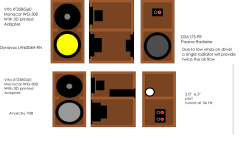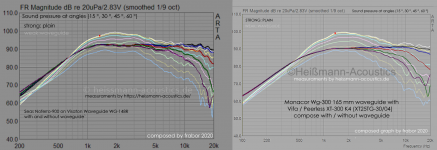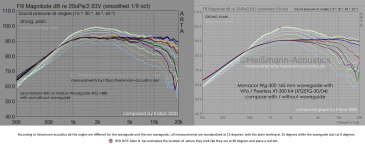Hi,
I am designing a two way speaker with a loaded tweeter on a waveguide and a 7" woofer.
Looking at using one of these two wave-guides, the Monacor W300 and the WG-148R by Vistason. The Vistason has USA distribution (low shipping available now) but the Monacor does not, and the shipping is kind of pricey at this point due to Covid. The driver can be attached directly to the Vistason but you need a 3d printed adapter for the Monacor
I am thinking about a XT19, SB19 or the XT 25.
It seems that the Vistason loads at 650Hz while the Monacor at about 450Hz (see attached graphs). Both are done by the same person under similar conditions but they are different tweeters, that is the best compassion I could get to determine the point of loading.
How can I calculate the minimal crossover frequency on the wave-guide ( I am shooting for the vicinity of 1500 Hz)?
Regarding the choice of waveguide, is the Monacor worth waiting for and the extra work of the adapter, or does the Vistason provide the desired frequency point and a good compromise?
Regarding the graph, Sound pressure at angles (15 °, 30 °, 45 °, 60 °)
Tks in advance
I am designing a two way speaker with a loaded tweeter on a waveguide and a 7" woofer.
Looking at using one of these two wave-guides, the Monacor W300 and the WG-148R by Vistason. The Vistason has USA distribution (low shipping available now) but the Monacor does not, and the shipping is kind of pricey at this point due to Covid. The driver can be attached directly to the Vistason but you need a 3d printed adapter for the Monacor
I am thinking about a XT19, SB19 or the XT 25.
It seems that the Vistason loads at 650Hz while the Monacor at about 450Hz (see attached graphs). Both are done by the same person under similar conditions but they are different tweeters, that is the best compassion I could get to determine the point of loading.
How can I calculate the minimal crossover frequency on the wave-guide ( I am shooting for the vicinity of 1500 Hz)?
Regarding the choice of waveguide, is the Monacor worth waiting for and the extra work of the adapter, or does the Vistason provide the desired frequency point and a good compromise?
Regarding the graph, Sound pressure at angles (15 °, 30 °, 45 °, 60 °)
Tks in advance
Attachments
Last edited:
It looks as though the Monocor doesn't work as well close to the driver, however it is generally more narrow than the Visaton, but not by much.
What are the angles shown?
What are the angles shown?
Why use one of those three drivers when you refer to measurements done with the renowned NoFerro? Both XT units exhibit a relatively strong D2 under 2kHz. I'd pick a 1" dome with less distortion if I wanted low X-over.
There are different benefits of using a waveguide. Since you're going to use this in a small loudspeaker, I believe you are not focusing on increasing SPL. I therefore think you're interested mainly in controlling the dispersion of the tweeter. If you are interested in getting the dispersion right, I'd recommend to measure the dispersion of the woofer and the tweeter+waveguide and find the frequency range were dispersion is the same for both drivers. This is where you should put the x-over frequency.
That said, I personally prefer the WG148 over the WG300, because the WG148 tends to yield smoother SPL response, especially at high frequencies. I guess this is because the WG148 is not as deep as the WG300.
Here are some of my measurements of the WG148:
https://www.diyaudio.com/forums/multi-way/327594-source-monkey-box-89.html#post5852940
Open source Waveguides for CNC & 3D printing!
That said, I personally prefer the WG148 over the WG300, because the WG148 tends to yield smoother SPL response, especially at high frequencies. I guess this is because the WG148 is not as deep as the WG300.
Here are some of my measurements of the WG148:
https://www.diyaudio.com/forums/multi-way/327594-source-monkey-box-89.html#post5852940
Open source Waveguides for CNC & 3D printing!
Hi Frabor: Have you considered Wavecor's TW030WA11/12?
The product includes a waveguide, saving you labor and logistics, and the manufacturer has done a good job of integrating the waveguide profile with the tweeter diaphragm shape, eliminating the need for a cut-and-try debugging process.
The TW030WA11/12 can absolutely be used with a 1500Hz crossover (or even lower, depending on SPL and crossover slope).
TW030WA11_12
Arguably, choosing an integrated solution may be less fun than trying to combine and integrate a waveguide made by one company with a tweeter made by another 🙂.
hth
The product includes a waveguide, saving you labor and logistics, and the manufacturer has done a good job of integrating the waveguide profile with the tweeter diaphragm shape, eliminating the need for a cut-and-try debugging process.
The TW030WA11/12 can absolutely be used with a 1500Hz crossover (or even lower, depending on SPL and crossover slope).
TW030WA11_12
Arguably, choosing an integrated solution may be less fun than trying to combine and integrate a waveguide made by one company with a tweeter made by another 🙂.
hth
My vote would be for the Vifa dome with double magnets and larger back chamber (low Fs) I think it's called DX25-something.. paired with the WG300 if you want to cross low.
If you're considering using the WG148, I'd suggest searching over on the PE forum for threads on the RST28 in the waveguide. It mates up perfectly with no adapter, and the measurements are very good. Can cross in the 1500 range without apparent problem.
RST28F in a Visaton waveguide -
Techtalk Speaker Building, Audio, Video Discussion Forum
RST28F in a Visaton waveguide -
Techtalk Speaker Building, Audio, Video Discussion Forum
Why use one of those three drivers when you refer to measurements done with the renowned NoFerro? Both XT units exhibit a relatively strong D2 under 2kHz. I'd pick a 1" dome with less distortion if I wanted low X-over.
As far as I can tell, the NoFerro tweeter isn't offered in North America. Or at least I came up empty when looking for it.
As far as I can tell, the NoFerro tweeter isn't offered in North America. Or at least I came up empty when looking for it.
I had the same experience. As far as I could tell the NoFerro is a Seas 27TDF without the ferrofluid. The 27TDF is also hard to find in the US as it's been replaced by the 27TDFC. I used the 27TDFC with the WG-148 and was happy with the result. I ended up with LR4 acoustic @ 2500 Hz for the tweeter xover.
PS - The 27TDFC has ferrofluid.
Last edited:
It looks as though the Monocor doesn't work as well close to the driver, however it is generally more narrow than the Visaton, but not by much.
What are the angles shown?
According to the author of the measurements, the angles are different for the waveguide and the non waveguide pots. He states that the all measurements are standardized at 15 degrees, with the plain starting at 15 degrees while the waveguide start at 0 degrees.
Why use one of those three drivers when you refer to measurements done with the renowned NoFerro? Both XT units exhibit a relatively strong D2 under 2kHz. I'd pick a 1" dome with less distortion if I wanted low X-over.
I used the NoFerro as an example to compare the performance of both waveguides, since the author of the measurements did not have a sample of the xt25 with the W300 and the WG-148R. I don’t think the NoFerro is available in the USA.
I choose the XT 19 and 25 since there were low cost ring radiators. For what I recall I read in a Patrick Bateman, soft domes and ring radiators work best in waveguides and hard domes do not work so well and 3 / 4” tweeters have some advantages (see attached graph) (I’ll try to look for the post and attach it).
What other tweeter driver can you suggest?
Link to the thread of the graph.
Attachments
Last edited:
Hi Frabor: Have you considered Wavecor's TW030WA11/12?
The product includes a waveguide, saving you labor and logistics, and the manufacturer has done a good job of integrating the waveguide profile with the tweeter diaphragm shape, eliminating the need for a cut-and-try debugging process.
The TW030WA11/12 can absolutely be used with a 1500Hz crossover (or even lower, depending on SPL and crossover slope).
TW030WA11_12
Arguably, choosing an integrated solution may be less fun than trying to combine and integrate a waveguide made by one company with a tweeter made by another 🙂.
hth
The Wavercor tw030wa11 specs look great, and it has the integrated waveguide that makes life simpler, but less fun for sure. It looks like a great driver and if I am correct is a 1 1/4" soft dome. I rather use a tweeter that is an inch or less to keep the beaming frequency as high as possible, optimally on or above 15Khz. (see prior post for Patrick Bateman explanation of beaming vs diameter).
Last edited:
Updated graph
Updated W300 and WG-148R comparison chart with Allen B. mods and suggestions.
Updated W300 and WG-148R comparison chart with Allen B. mods and suggestions.
Attachments
Last edited:
I choose the XT 19 and 25 since there were low cost ring radiators. For what I recall I read in a Patrick Bateman, soft domes and ring radiators work best in waveguides and hard domes do not work so well and 3 / 4” tweeters have some advantages (see attached graph) (I’ll try to look for the post and attach it).
Whatever waveguide you pick, if you want to cross low, use a tweeter with low distortion around 1kHz. The alternatives to the NoFerro have been mentioned earlier, but really any decent performing dome (including metal domes) will do. Don't focus on irregularities in the domain above 12kHz too much, distortion patterns around 1-2kHz are more important.
Whatever waveguide you pick, if you want to cross low, use a tweeter with low distortion around 1kHz. The alternatives to the NoFerro have been mentioned earlier, but really any decent performing dome (including metal domes) will do. Don't focus on irregularities in the domain above 12kHz too much, distortion patterns around 1-2kHz are more important.
Thanks for the info. I believe the NoFerro has been discontinued as I cannot find it anywhere for sale. I cannot even find it on the list of active drivers in the Seas page. So I ascertain that you do not believe that Xt25, with bad distortion patterns around that frequency, are a good idea.
There are different benefits of using a waveguide. Since you're going to use this in a small loudspeaker, I believe you are not focusing on increasing SPL. I therefore think you're interested mainly in controlling the dispersion of the tweeter. If you are interested in getting the dispersion right, I'd recommend to measure the dispersion of the woofer and the tweeter+waveguide and find the frequency range were dispersion is the same for both drivers. This is where you should put the x-over frequency.
That said, I personally prefer the WG148 over the WG300, because the WG148 tends to yield smoother SPL response, especially at high frequencies. I guess this is because the WG148 is not as deep as the WG300.
Here are some of my measurements of the WG148:
https://www.diyaudio.com/forums/multi-way/327594-source-monkey-box-89.html#post5852940
Open source Waveguides for CNC & 3D printing!
Thks for the links for the os monkey box. great thread. I was almost decidet to get the W-148r as it is the easiest solution as I can get it in the usa in and with the w300 the shipping is more than the part. I have been also folllowing augerpro designs. it will be cool to mold them and print them, the price for an sls print in shapeways is obscene.
U are right, I do not care about increasing SPL as most of the drivers that can get in 6-8" close to 40 Hz have efficiency specs about 85-88 dB, below the tweeter without a waveguide. Regarding the dispersion, how do you suggest to measure the dispersion of the tweeter and the woofer.
Mi goal with this project is to make a speaker using great value drivers, i.e. not the best, as the "best" is always insanely expensive, but the ones that the curve of price and performance meets at the sweet spot. Cost is important as the pesky 308P II is about $200 and that is my upper bound per box.
Since the tweeter will more than likely will have to be attenuated, and dispersion not spl is the game , why not go in a different direction." HT1-1746 Celestion CDX1-1746 Compression driver + 6.5 inch shallow Horn Tweeter" The Celstion is a great Compression driver, sometimes refereed as the poor men de250, and in as much as the waveguide does not make it justice, and that it will need to be matched and attenuated with the woofer, well, the combo price is in the same range cost and I believe it can be crossed at a similar xover point to the rest of the tweeter in this list. Well, it is even cheaper that the Wavecor and if not better is cooler 🙂
- Home
- Loudspeakers
- Multi-Way
- Determining the minimal crossover frequency on a waveguide loaded tweeter.





